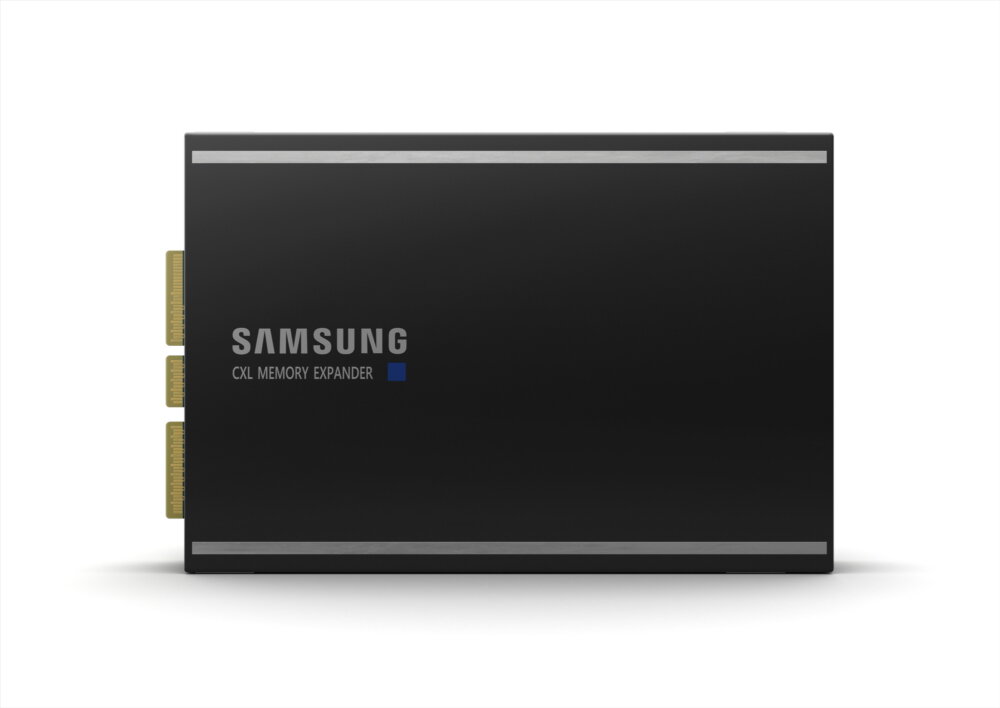Samsung has developed the so-called CXL memory expander so that high-performance computers have extended access to main memory beyond the limits of classic DRAM channels. The module, which uses the Compute Express Link based on PCIe 5.0, is equipped with DDR5 memory.
The Compute Express Link (CXL) introduced by Intel two years ago is intended to connect processors, memory and specialized accelerator chips such as FPGAs and network ICs with low latency and high throughput rates in the data center. In the meantime, numerous companies are participating in the further development of CXL, which is increasingly becoming the new interconnect standard. For example, AMD and Samsung initially only followed the very similar competing technology CCIX, but both now also belong to the enormously increased CXL membership group, which includes almost all the major players in the industry. It is at least unlikely that CCIX will prevail in parallel.
Samsung CXL Memory Expander
As one of the first products and an application example, Samsung presented the CXL Memory Expander. The module is apparently designed in the E3.S form factor, which was actually designed for server SSDs, and has a PCIe x16 connection. It is interesting that Samsung has labeled the images with “Samsung-CXL-SSD”, although volatile DDR5 memory is used.
Assuming that CXL initially uses PCIe 5.0 with 32 GT/s, this results in a maximum data transfer rate of around 63 GB/s minus overhead with 16 lanes. For the future, however, CXL plans to use PCIe 6.0.
-
Image 1 of 2
However, Samsung does not yet provide any technical key data for the CXL module and only speaks of equipping it with DDR5 RAM. The fact that Samsung says that the CXL interface enables “scaling of the storage capacity to terabyte level” is only a vague indication of the possible storage volume. Especially since current platforms have long since advanced into the range of 1 terabyte of RAM or more.
GPUs and other accelerators also receive fast memory access
The idea behind such CXL memory modules, however, is that not only the processor, but also accelerator chips, for example, have direct access to the RAM via CXL, which significantly improves the transfer rates and latencies. Access by GPUs to this additional memory pool is also explicitly stated.
Unlike conventional DDR-based memory , which has limited memory channels, Samsung's CXL-enabled DDR5 module can scale memory capacity to the terabyte level, while dramatically reducing system latency caused by memory caching.
In addition to CXL hardware innovation, Samsung has incorporated several controllers and software technologies like memory mapping, interface converting and error management, which will allow CPUs or GPUs to recognize the CXL-based memory and utilize it as the main memory.
Samsung
Samsung mentions artificial intelligence (AI) or high-performance computing (HPC) as potential areas of application. Future supercomputers could be equipped accordingly.
Validation for upcoming Intel platforms
Finally, Samsung explains that the CXL memory module has already been successfully validated for the new generation of server platforms from Intel. Samsung is also working with providers of data centers and cloud systems in this regard.
As is well known, these upcoming Intel platforms include Sapphire Rapids with support for CXL 1.1, DDR5 and PCIe 5.0. The introduction of Sapphire Rapids is not expected until the end of 2021 at the earliest.
Meanwhile, in November 2020, the next step for the Compute Express Link with CXL 2.0 was announced, but it will be will only find its way into systems in a few years.
The editorial team thanks community member “Konkretor” for pointing this out to this news.
